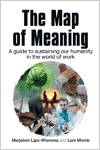 Marjolein Klips-Wiersma and Lani Morris. The Map of Meaning: A Guide to Sustaining Our Humanity in the World of Work. Sheffield, UK: Greenleaf Publications, 2011.
Marjolein Klips-Wiersma and Lani Morris. The Map of Meaning: A Guide to Sustaining Our Humanity in the World of Work. Sheffield, UK: Greenleaf Publications, 2011.
This book is exactly the kind of thing we should be looking forward to as a result of our efforts to meet the complexity facing us head on and in a way that facilitates our building clarity and meaning. The authors are offering a “holistic development model” that “helps to keep the human search for meaning alive, especially in the face of the challenges that exist in organisational life.” These New Zealand and British authors seek to help us all open up meaning both at the individual and the organizational (or collective) levels.
They seek to help us as individuals to
• Identify and define what is important,
• Effectively converse with others about what is important to them,
• Integrate all the things that are important into decision-making.
• Develop ourselves as whole persons who are integrated internally,
• Clarify and adjust our focus under changing conditions, and
• Take personal responsibility for one’s life and work,
And to help us as groups to
• Have meaningful conversations,
• Identify the universal themes that make life worthwhile and respecting worldview differences,
• Face challenges together constructively, and
• Find energizing ways of working together on what is important.
And at the organizational level
• Create meaningful workplaces together,
• Have deeper levels of engagement while re-energizing the workplace,
• Develop shared vision and value statements,
• Affirm meaningfulness as a fundamental human need and for human systems,
• Conduct meaningful work practices that are aligned,
• “And, as a result,” work steadily, purposefully, collaboratively and sustainably.”
Their focus on the idea of meaningfulness is more than worthwhile, They make a crucial point that in the field of leadership (and elsewhere) we readily forget: “Our ability to engage with meaning is helped or hindered by the words we and others use. Words are not neutral; the same word has different connotations for different people.” There are two aspects of this. One is about how we use words sloppily. Meaning is obscured. And then we build structures of models, concepts and theories, action steps and interventions in the muck of a swamp of our own vague meanings. The second is in communicating across worldviews and value sets. What works for us may not work for others.
Their approach is based on four pathways:
• Developing the inner self,
• Unity with others,
• Expressing full potential
• Service to others.
The authors recognize that their labels and the words they have chosen for the parsing of these paths may not work for everyone. Nevertheless, somehow these elements need to be addressed in being and working effectively. Their approach lays out elements of moral development, personal growth, and being true to oneself. They explore sharing and belongingness in working together. They engage the tensions among these paths among among those of us in the context of work. While they have bit off a great deal for this book, this is the kind of thinking and presentation that we must encourage in the face of our individual and collective challenges. Otherwise, we are doomed to the worlds of 1984 and Animal Farm or some post-apocalyptic misery.
